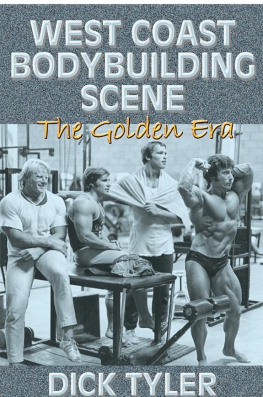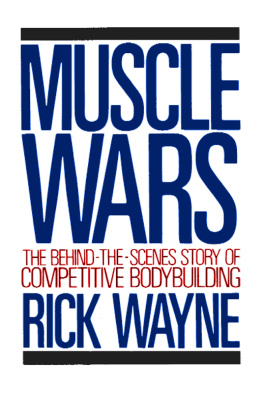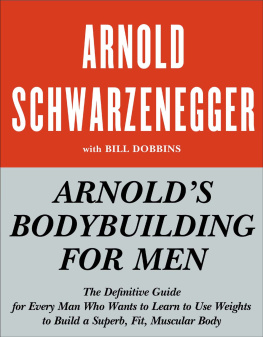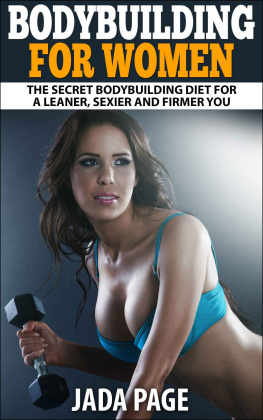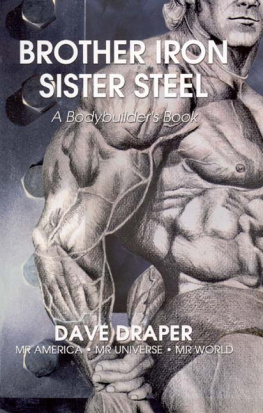All rights reserved. No part of this book may be reproduced or transmitted in any form whatsoever without written permission from the author or publisher, except for the inclusions of brief quotations in articles or reviews.
Tyler, Dick.
West Coast bodybuilding scene : the golden era / Dick Tyler ; foreword by Dave Draper ; [captions by Dave Draper].
p. cm.
Includes bibliographical references and index.
ISBN 1-931046-29-8 (trade paper)
1. BodybuildingCaliforniaHistory. 2.
BodybuildersCaliforniaInterviews. I. Title.
GV546.5 .T95 2004
646.7509794dc22
2003022246
Foreword
Musclebuilding, I suspect, is as old as the hills. When man first realized women were attracted to a slick, muscular body and discovered that rocks, prey, mischievous cave dwellers and monsters were lifted more easily with a mighty back and strong arms, he put his genius to work, and thus his body, to improve his sinewy assets. The Dinosaur Championships held in 10,000 BC crowned the original Mr. World and records were established in rock snatches and boulder clean-and-jerks.
The movement had begun and the next thing you know John Grimek is Mr. America and Steve Reeves is making Hercules films. This muscle stuff is becoming popular; theres a subculture budding in the grungy YMCAs and garages across the statesits spreading to the sunny beaches of California and before long it will be mainstream.
And so the stage is set for the West Coast Bodybuilding Scene, that time in the history of weightlifting when bodybuilding neared critical mass, swirled in its growing energy and attracted its grand external source of power, the spectators. It was the Golden Era of Bodybuilding, new, young, alive, untainted, unworn, unexploited and adored. The spectators became fans.
West Coast Bodybuilding Scene is about a particular group of people with a special interest who inhabited a small region of California during a short period of time. Dick Tyler experienced, observed and recorded this golden stretch of bodybuilding history between 65 and 71 as a journalist, as a participant and as a weight-lifting devotee. His eyes and ears were acute and his love for the sport was wrapped up in an affectionate sense of humor, the most accurate and appealing conduit of delivery for this unique physical expression.
You see, bodybuilding is a sport, an art form, a diversion, a hobby, an obsession, a competition, a love affair and a lifestyle.
Things heated up around the world in the 60s. Life became restless. Emotions and passions of the sensitive and few picked up the current, responded to the eddies and felt the vibe. Men looked for something to hold onto, to keep them ready and balanced, directed yet entertainediron and steel, muscle and might. Muscle Beach, too wonderful to endure, sadly unraveled. Individuals surfaced in its place and what simmered for years was ready to erupt in slow motion.
Watch the passionate explosion of events from the lens of the cameras whose shutters were triggered at the most perfect moment by artists Russ Warner and Artie Zeller, Jimmy Caruso and Gene Mozee. Few photographers have witnessed in their viewfinders the vivid story which is about to unfold. Those same picture-takers engendered the events, stimulated bodybuildings progress, universally popularized physical fitness and recorded the stunning occasions now known as history.
There were only a handful of weightlifters, powerlifters and bodybuilders during this natural period of bodybuilding development. And in the U.S. three men and their magazinesPeary Rader with Ironman, Bob Hoffman with Strength and Health and Joe Weider with Mr. America and Muscle Buildersought to expand the sport and popularize its participants.
Popularize soon became known as capitalize. It was during the Golden Era when the machinery of competition and marketing magnified and amplified the activities of muscle and might, iron and steel, and went on to create the rather large pool of spectators and participants of all shapes and sizes we know today. Bodybuilding, once a puppy with a wagging tail, is now a monster. I do not say this without affection. Monsters can be cute.
My name is Dave Draper and I had the precious advantage (graced by God, actually) of being in the middle of it all. And Im in the middle of it all again. The years have come and gone and tons of weights have moved up and down. I, as you, love this stuff and I cant, nor do I wish to, put it aside.
The story is accompanied by 160 pictures worth a thousand words, and I slip in my two cents to comment on the black and white portrayals and keep you apprised of names, dates, places and events.
As this is not a history from which to learn, but a memory to share and delight in, a stiff and factual account gives way to loose continuity. There was a marriage in minds and souls of Dick and Artie that cannot be duplicated and their synergy provides an insight into a beautiful past that no historian or scholar could ever understand.
Life happens once. Only here may it happen again. Have fun and Gods speed.
Dave Draper
Santa Cruz, California
Preface
When I was fourteen years old I looked in the mirror and decided if I just had a bit more muscle the girls would be mad about me. Hmmm. Now just how could this be done?
About a month or so later I came across a magazine at a newsstand. Its name was Muscle Power and it had on the cover a photo of a man with the biggest set of muscles I had ever seen. Inside was an article about him with a picture of him flexing his incredible biceps. That was it! Here was the secret of eternal, everlasting, magnificent, all-powerful, triumphant, girl-catching manhood. How did he get that way? The magazine clearly stated the only way I could get massive biceps, turnip-shaped thighs, diamond-shaped calves, melon-shaped deltoids, granite pecs and washboard abs was to lift Weider weights and follow the Weider System of bodybuilding. I bought the magazine and carried it so the cover was showingI hoped anyone looking at me would think I was a muscleman, too.
I got a set of weights and a training partner and set up the gym in my garage. This was in the 1940s and was the beginning of a way of life I follow to this day.
But things were a little different then. Bodybuilding had only a few hardcore disciples. The average person thought of a bodybuilder as some kind of musclebound freak who would have a difficult time trying to tie his shoelaces. Anytime I could talk someone into going to a physique contest they would end up laughing and making fun of the thing I took so seriouslyall except my training partner, who was as nuts as I was.
After a few months, my friend and I felt we had cultivated enough turnips and melons to challenge a professional wrestler in the ring, but were gratefully saved from probable death by the ushers at the arena.
Things were so differentno two bodybuilders looked the sameyou could tell who was who just by their shape. If all you saw was a silhouette, you could tell a John Grimek from an Alan Stephan or George Eiferman or Marvin Eder or Steve Reeves or Clarence Ross or Vince Gironda or Eric Pedersen. Everyone came with a different set of muscles and a different personality.

